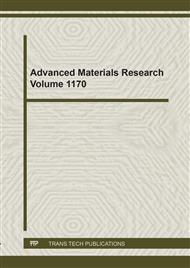[1]
World Health Organization, Arsenic in Drinking-water Background document for development of WHO Guidelines for Drinking-water Quality,, (2011).
Google Scholar
[2]
Atsdr, Toxicological Profile for Arsenic,, (2007).
Google Scholar
[3]
Z. N. Garba, C. E. Gimba, and A. Galadima, Arsenic Contamination of Domestic Water from Northern Nigeria,, International Journal of Science and Technology, vol. 2, no. 1, 2012, [Online]. Available: http://www.ejournalofsciences.org.
Google Scholar
[4]
M. Asadullah, I. Jahan, M. B. Ahmed, P. Adawiyah, N. H. Malek, and M. S. Rahman, Preparation of microporous activated carbon and its modification for arsenic removal from water,, Journal of Industrial and Engineering Chemistry, vol. 20, no. 3, p.887–896, May 2014,.
DOI: 10.1016/j.jiec.2013.06.019
Google Scholar
[5]
D. Pokhrel and T. Viraraghavan, Arsenic removal from an aqueous solution by a modified fungal biomass,, Water Research, vol. 40, no. 3, p.549–552, 2006,.
DOI: 10.1016/j.watres.2005.11.040
Google Scholar
[6]
I. Jahan, A. Motin, M. Moniuzzaman, and M. Asadullah, Notes Arsenic removal from water using activated carbon obtained from chemical activation of jute stick,, (2008).
Google Scholar
[7]
T. Khan and M. Chaudhuri, Adsorption of arsenate from aqueous solution by rice husk-based adsorbent,, in IOP Conference Series: Earth and Environmental Science, 2013, vol. 16, no. 1,.
DOI: 10.1088/1755-1315/16/1/012095
Google Scholar
[8]
S. Yao, Z. Liu, and Z. Shi, Arsenic removal from aqueous solutions by adsorption onto iron oxide/activated carbon magnetic composite,, Journal of Environmental Health Science and Engineering, vol. 12, no. 1, 2014,.
DOI: 10.1186/2052-336x-12-58
Google Scholar
[9]
N. K. Niazi et al., Arsenic removal by Japanese oak wood biochar in aqueous solutions and well water: Investigating arsenic fate using integrated spectroscopic and microscopic techniques,, Science of the Total Environment, vol. 621, p.1642–1651, Apr. 2018,.
DOI: 10.1016/j.scitotenv.2017.10.063
Google Scholar
[10]
K. C. M. Kwok, L. F. Koong, T. al Ansari, and G. McKay, Adsorption/desorption of arsenite and arsenate on chitosan and nanochitosan,, Environmental Science and Pollution Research, vol. 25, no. 15, p.14734–14742, May 2018,.
DOI: 10.1007/s11356-018-1501-9
Google Scholar
[11]
T. Anemana et al., Granular activated charcoal from peanut (Arachis hypogea) shell as a new candidate for stabilization of arsenic in soil,, Microchemical Journal, vol. 149, Sep. 2019,.
DOI: 10.1016/j.microc.2019.104030
Google Scholar
[12]
A. A. Haji and N. M. Sh. Mohammed, Optimization of Arsenic Adsorption onto Cativated Carbon Dreived from Potato Peel Using Response Surfase Methodology,, Science Journal of University of Zakho, vol. 7, no. 2, Jun. 2019,.
DOI: 10.25271/sjuoz.2019.7.2.594
Google Scholar
[13]
D. Humelnicu, L. Valentin Soroaga, C. Arsene, I. Humelnicu, and R. I. Olariu, Adsorptive performance of soy bran and mustard husk towards arsenic (V) ions from synthetic aqueous solutions,, Acta Chimica Slovenica, vol. 66, no. 2, p.326–336, 2019,.
DOI: 10.17344/acsi.2018.4821
Google Scholar
[14]
E. Koohzad, D. Jafari, and H. Esmaeili, Adsorption of Lead and Arsenic Ions from Aqueous Solution by Activated Carbon Prepared from Tamarix Leaves,, ChemistrySelect, vol. 4, no. 42, p.12356–12367, Nov. 2019,.
DOI: 10.1002/slct.201903167
Google Scholar
[15]
V. Manirethan, K. Raval, and R. M. Balakrishnan, Adsorptive removal of trivalent and pentavalent arsenic from aqueous solutions using iron and copper impregnated melanin extracted from the marine bacterium Pseudomonas stutzeri,, Environmental Pollution, vol. 257, Feb. 2020,.
DOI: 10.1016/j.envpol.2019.113576
Google Scholar
[16]
Z. Wang, W. Hu, Z. Kang, X. He, Z. Cai, and B. Deng, Arsenate adsorption on iron-impregnated ordered mesoporous carbon: Fast kinetics and mass transfer evaluation,, Chemical Engineering Journal, vol. 357, p.463–472, Feb. 2019,.
DOI: 10.1016/j.cej.2018.09.074
Google Scholar
[17]
J. A. Rodríguez-Romero et al., Preparation of a new adsorbent for the removal of arsenic and its simulation with artificial neural network-based adsorption models,, Journal of Environmental Chemical Engineering, vol. 8, no. 4, p.103928, Aug. 2020,.
DOI: 10.1016/j.jece.2020.103928
Google Scholar
[18]
G. Tan, Y. Mao, H. Wang, and N. Xu, A comparative study of arsenic(V), tetracycline and nitrate ions adsorption onto magnetic biochars and activated carbon,, Chemical Engineering Research and Design, vol. 159, p.582–591, Jul. 2020,.
DOI: 10.1016/j.cherd.2020.05.011
Google Scholar
[19]
Y. Wang, H. Liu, S. Wang, X. Li, X. Wang, and Y. Jia, Simultaneous removal and oxidation of arsenic from water by δ-MnO2 modified activated carbon,, Journal of Environmental Sciences (China), vol. 94, p.147–160, Aug. 2020,.
DOI: 10.1016/j.jes.2020.03.006
Google Scholar
[20]
A. Ahmad and I. M. Muhammad Innovative granular activated carbon from black velvet tamarind (Dialium guineense) fruit shell,, Unpublished.
Google Scholar
[21]
F. Çeçen, Activated Carbon,, Kirk-Othmer Encyclopedia of Chemical Technology. p.1–34, Apr. 28, 2014,.
DOI: 10.1002/0471238961.0103200902011105.a01.pub3
Google Scholar
[22]
A. O. Dada, A. P. Olalekan, A. M. Olatunya, and Dada, Langmuir, Freundlich, Temkin and Dubinin-Radushkevich Isotherms Studies of Equilibrium Sorption of Zn 2+ Unto Phosphoric Acid Modified Rice Husk., [Online]. Available: www.iosrjournals.org.
DOI: 10.9790/5736-0313845
Google Scholar
[23]
K. Y. Foo and B. H. Hameed, Insights into the modeling of adsorption isotherm systems,, Chemical Engineering Journal, vol. 156, no. 1. p.2–10, Jan. 01, 2010,.
DOI: 10.1016/j.cej.2009.09.013
Google Scholar
[24]
S. Ansanay-Alex, C. Lomenech, C. Hurel, and N. Marmier, Adsorption of nickel and arsenic from aqueous solution on natural sepiolite,, (2012).
DOI: 10.1504/ijnt.2012.045327
Google Scholar
[25]
N. K. Niazi et al., Arsenic removal by Japanese oak wood biochar in aqueous solutions and well water: Investigating arsenic fate using integrated spectroscopic and microscopic techniques,, Science of the Total Environment, vol. 621, p.1642–1651, Apr. 2018,.
DOI: 10.1016/j.scitotenv.2017.10.063
Google Scholar
[26]
M. K. Mondal and R. Garg, A comprehensive review on removal of arsenic using activated carbon prepared from easily available waste materials,, Environmental Science and Pollution Research, vol. 24, no. 15, p.13295–13306, May 2017,.
DOI: 10.1007/s11356-017-8842-7
Google Scholar
[27]
C. Wang, H. Luo, Z. Zhang, Y. Wu, J. Zhang, and S. Chen, Removal of As(III) and As(V) from aqueous solutions using nanoscale zero valent iron-reduced graphite oxide modified composites,, Journal of Hazardous Materials, vol. 268, p.124–131, Mar. 2014,.
DOI: 10.1016/j.jhazmat.2014.01.009
Google Scholar


